Parametric Excitation of Optomechanical Resonators by Periodical Modulation
Abstract
:1. Introduction
2. Fabrication and Experimental Setup
3. Experimental Results and Discussions
3.1. Optical Characterization of the Racetrack Optical Cavity
3.2. Optical Characterization of the Mechanical Cantilever
3.3. Excitation of the Mechanical Cantilever
4. Conclusions
Acknowledgments
Author Contributions
Conflicts of Interest
References
- Accadia, T.; Acernese, F.; Alshourbagy, M.; Amico, P.; Antonucci, F.; Aoudia, S.; Arnaud, N.; Arnault, C.; Arun, K.; Astone, P. Virgo: A laser interferometer to detect gravitational waves. J. Instrum. 2012, 7, P03012. [Google Scholar] [CrossRef]
- Pirkkalainen, J.-M.; Damskägg, E.; Brandt, M.; Massel, F.; Sillanpää, M. Squeezing of quantum noise of motion in a micromechanical resonator. Phys. Rev. Lett. 2015, 115, 243601. [Google Scholar] [CrossRef] [PubMed]
- Rocheleau, T.; Ndukum, T.; Macklin, C.; Hertzberg, J.; Clerk, A.; Schwab, K. Preparation and detection of a mechanical resonator near the ground state of motion. Nature 2010, 463, 72–75. [Google Scholar] [CrossRef] [PubMed]
- Weiss, T.; Nunnenkamp, A. Quantum limit of laser cooling in dispersively and dissipatively coupled optomechanical systems. Phys. Rev. A 2013, 88, 023850. [Google Scholar] [CrossRef]
- Li, M.; Pernice, W.; Xiong, C.; Baehr-Jones, T.; Hochberg, M.; Tang, H. Harnessing optical forces in integrated photonic circuits. Nature 2008, 456, 480–484. [Google Scholar] [CrossRef] [PubMed]
- Ren, M.; Huang, J.; Cai, H.; Tsai, J.M.; Zhou, J.; Liu, Z.; Suo, Z.; Liu, A.-Q. Nano-optomechanical actuator and pull-back instability. ACS Nano 2013, 7, 1676–1681. [Google Scholar] [CrossRef] [PubMed]
- Singh, V.; Bosman, S.; Schneider, B.; Blanter, Y.M.; Castellanos-Gomez, A.; Steele, G. Optomechanical coupling between a multilayer graphene mechanical resonator and a superconducting microwave cavity. Nat. Nanotechnol. 2014, 9, 820–824. [Google Scholar] [CrossRef] [PubMed]
- Weis, S.; Rivière, R.; Deléglise, S.; Gavartin, E.; Arcizet, O.; Schliesser, A.; Kippenberg, T.J. Optomechanically induced transparency. Science 2010, 330, 1520–1523. [Google Scholar] [CrossRef] [PubMed]
- Teufel, J.; Donner, T.; Li, D.; Harlow, J.; Allman, M.; Cicak, K.; Sirois, A.; Whittaker, J.D.; Lehnert, K.; Simmonds, R.W. Sideband cooling of micromechanical motion to the quantum ground state. Nature 2011, 475, 359. [Google Scholar] [CrossRef] [PubMed]
- Chan, J.; Alegre, T.M.; Safavi-Naeini, A.H.; Hill, J.T.; Krause, A.; Gröblacher, S.; Aspelmeyer, M.; Painter, O. Laser cooling of a nanomechanical oscillator into its quantum ground state. Nature 2011, 478, 89. [Google Scholar] [CrossRef] [PubMed]
- Schliesser, A.; Kippenberg, T.J. Cavity optomechanics with whispering-gallery mode optical micro-resonators. Adv. Atomic Mol. Opt. Phys. 2010, 58, 207–323. [Google Scholar]
- Bagheri, M.; Poot, M.; Li, M.; Pernice, W.P.; Tang, H.X. Dynamic manipulation of nanomechanical resonators in the high-amplitude regime and non-volatile mechanical memory operation. Nat. Nanotechnol. 2011, 6, 726–732. [Google Scholar] [CrossRef] [PubMed]
- Rosenberg, J.; Lin, Q.; Painter, O. Static and dynamic wavelength routing via the gradient optical force. Nat. Photon. 2009, 3, 478–483. [Google Scholar] [CrossRef]
- Miao, H.; Srinivasan, K.; Aksyuk, V. A microelectromechanically controlled cavity optomechanical sensing system. New J. Phys. 2012, 14, 075015. [Google Scholar] [CrossRef]
- Jayich, A.; Sankey, J.; Zwickl, B.; Yang, C.; Thompson, J.; Girvin, S.; Clerk, A.; Marquardt, F.; Harris, J. Dispersive optomechanics: A membrane inside a cavity. New J. Phys. 2008, 10, 095008. [Google Scholar] [CrossRef]
- Zhang, J.; Liu, Y.-X.; Nori, F. Cooling and squeezing the fluctuations of a nanomechanical beam by indirect quantum feedback control. Phys. Rev. A 2009, 79, 052102. [Google Scholar] [CrossRef]
- Chang, D.E.; Regal, C.; Papp, S.; Wilson, D.; Ye, J.; Painter, O.; Kimble, H.J.; Zoller, P. Cavity opto-mechanics using an optically levitated nanosphere. Proc. Natl. Acad. Sci. USA 2010, 107, 1005–1010. [Google Scholar] [CrossRef] [PubMed]
- Elste, F.; Girvin, S.; Clerk, A. Quantum noise interference and backaction cooling in cavity nanomechanics. Phys. Rev. Lett. 2009, 102, 207209. [Google Scholar] [CrossRef] [PubMed]
- Navarro-Urrios, D.; Capuj, N.E.; Gomis-Bresco, J.; Alzina, F.; Pitanti, A.; Griol, A.; Martinez, A.; Torres, C.S. A self-stabilized coherent phonon source driven by optical forces. Sci. Rep. 2015, 5, 15733. [Google Scholar] [CrossRef] [PubMed]
- Mari, A.; Eisert, J. Gently modulating optomechanical systems. Phys. Rev. Lett. 2009, 103, 213603. [Google Scholar] [CrossRef] [PubMed]
- Tan, H.; Li, G.; Meystre, P. Dissipation-driven two-mode mechanical squeezed states in optomechanical systems. Phys. Rev. A 2013, 87, 033829. [Google Scholar] [CrossRef]
- Ramos, D.; Mertens, J.; Calleja, M.; Tamayo, J. Phototermal self-excitation of nanomechanical resonators in liquids. Appl. Phys. Lett. 2008, 92, 173108. [Google Scholar] [CrossRef]
- Deotare, P.B.; Bulu, I.; Frank, I.W.; Quan, Q.; Zhang, Y.; Ilic, R.; Loncar, M. All optical reconfiguration of optomechanical filters. Nat. Commun. 2012, 3, 846. [Google Scholar] [CrossRef] [PubMed]
- Groenesteijn, J.; Droogendijk, H.; Wiegerink, R.J.; Lammerink, T.S.; Lötters, J.C.; Sanders, R.G.; Krijnen, G.J. Parametric amplification in a micro coriolis mass flow sensor. J. Appl. Phys. 2014, 115, 194503. [Google Scholar] [CrossRef]
- Cleland, A.N. Thermomechanical noise limits on parametric sensing with nanomechanical resonators. New J. Phys. 2005, 7, 235. [Google Scholar] [CrossRef]
- Sharma, M.; Sarraf, E.H.; Cretu, E. Parametric amplification/damping in MEMS gyroscopes. In Proceedings of the 2011 IEEE 24th International Conference on Micro Electro Mechanical Systems (MEMS), Cancun, Mexico, 23–27 January 2011; pp. 617–620. [Google Scholar]
- Gallacher, B.; Burdess, J.; Harish, K. A control scheme for a MEMS electrostatic resonant gyroscope excited using combined parametric excitation and harmonic forcing. J. Micromech. Microeng. 2006, 16, 320. [Google Scholar] [CrossRef]
- Dong, B.; Cai, H.; Chin, L.K.; Huang, J.; Yang, Z.; Gu, Y.; Ng, G.I.; Ser, W.; Kwong, D.; Liu, A.Q. A silicon-nanowire memory driven by optical gradient force induced bistability. Appl. Phys. Lett. 2015, 107, 261111. [Google Scholar] [CrossRef]
- Ren, M.; Cai, H.; Chin, L.K.; Huang, J.; Gu, Y.; Radhakrishnan, K.; Ser, W.; Liu, A.Q. An opto-mechanical coupled-ring reflector driven by optical force for lasing wavelength control. Appl. Phys. Lett. 2016, 108, 081106. [Google Scholar] [CrossRef]
- Yu, Y.; Zhang, J.; Bourouina, T.; Liu, A. Optical-force-induced bistability in nanomachined ring resonator systems. Appl. Phys. Lett. 2012, 100, 093108. [Google Scholar] [CrossRef]
- Sankey, J.C.; Yang, C.; Zwickl, B.M.; Jayich, A.M.; Harris, J.G. Strong and tunable nonlinear optomechanical coupling in a low-loss system. Nat. Phys. 2010, 6, 707. [Google Scholar] [CrossRef]
- Leijssen, R.; La Gala, G.R.; Freisem, L.; Muhonen, J.T.; Verhagen, E. Nonlinear cavity optomechanics with nanomechanical thermal fluctuations. Nat. Commun. 2017, 8. [Google Scholar] [CrossRef] [PubMed]
- Karabalin, R.; Cross, M.; Roukes, M. Nonlinear dynamics and chaos in two coupled nanomechanical resonators. Phys. Rev. B 2009, 79, 165309. [Google Scholar] [CrossRef]
- Kozinsky, I.; Postma, H.C.; Bargatin, I.; Roukes, M. Tuning nonlinearity, dynamic range, and frequency of nanomechanical resonators. Appl. Phys. Lett. 2006, 88, 253101. [Google Scholar] [CrossRef]
- Lemonde, M.-A.; Didier, N.; Clerk, A.A. Nonlinear interaction effects in a strongly driven optomechanical cavity. Phys. Rev. Lett. 2013, 111, 053602. [Google Scholar] [CrossRef] [PubMed]
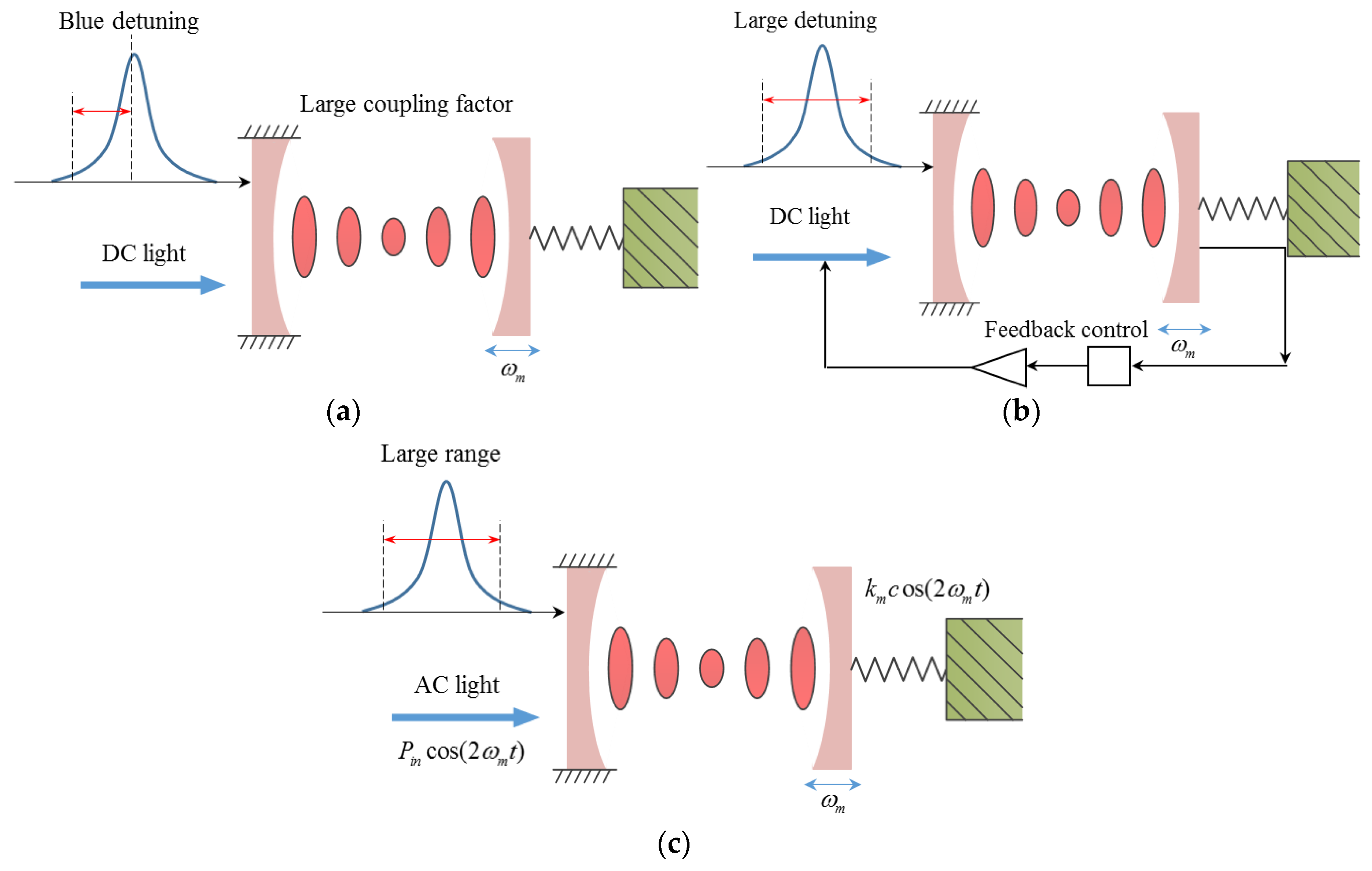
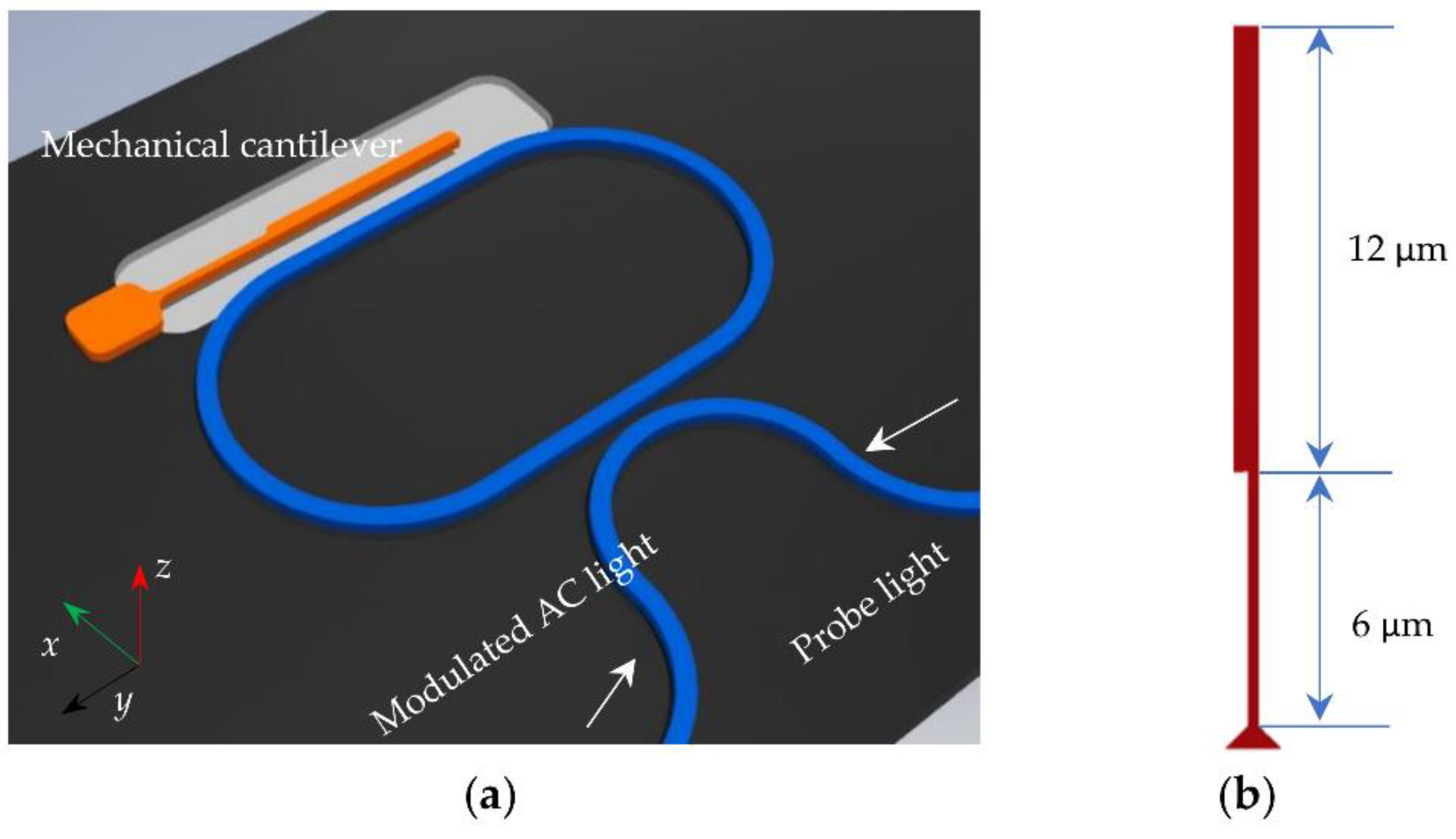

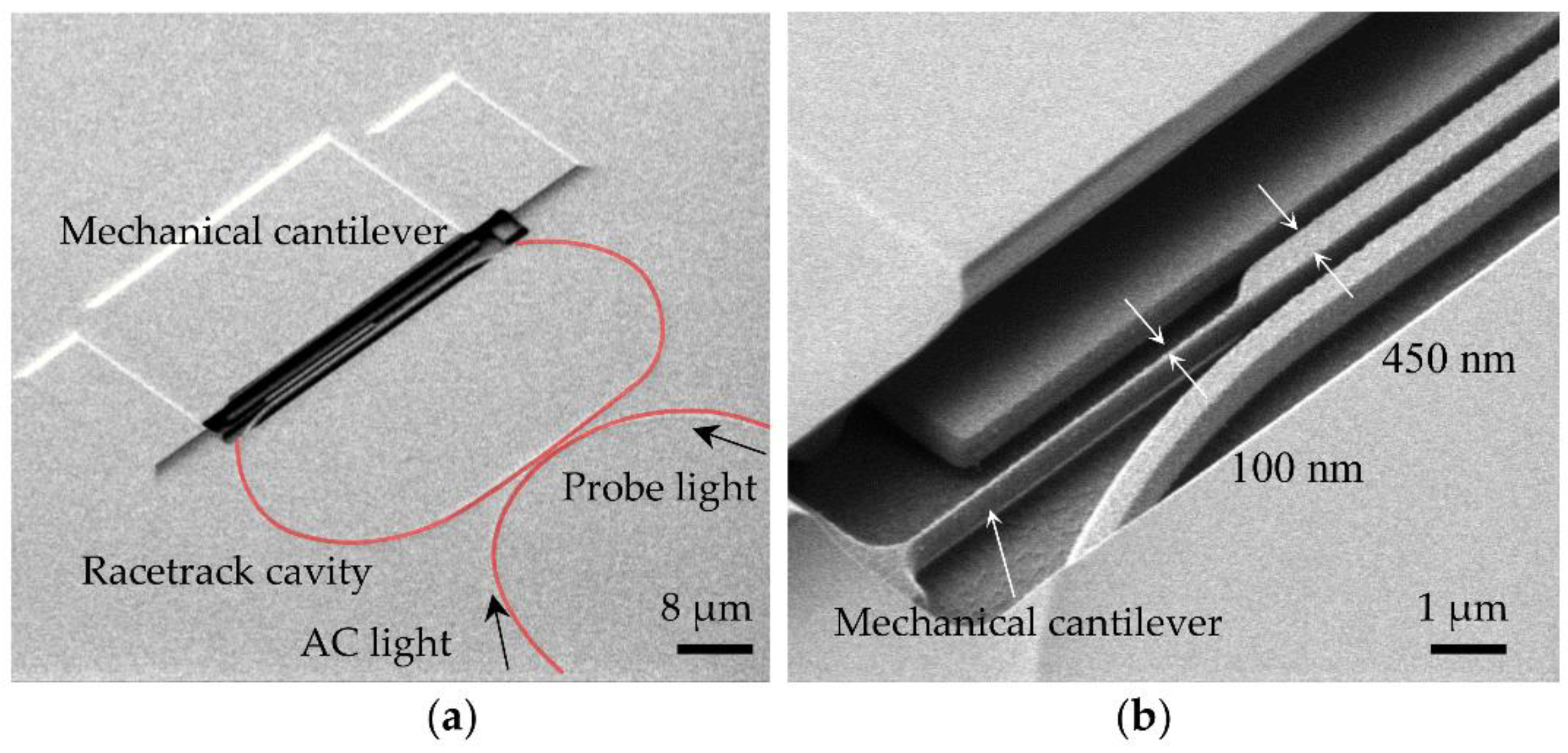

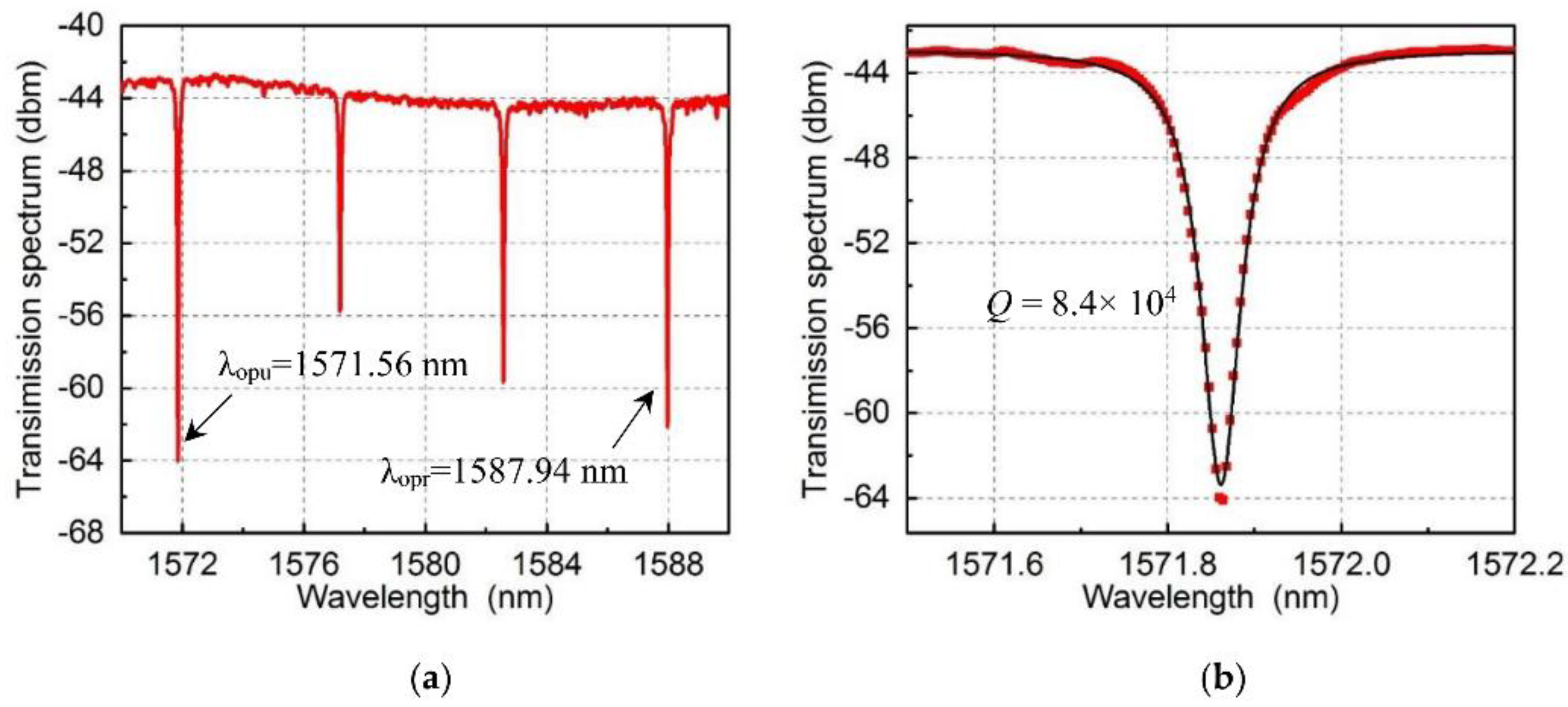
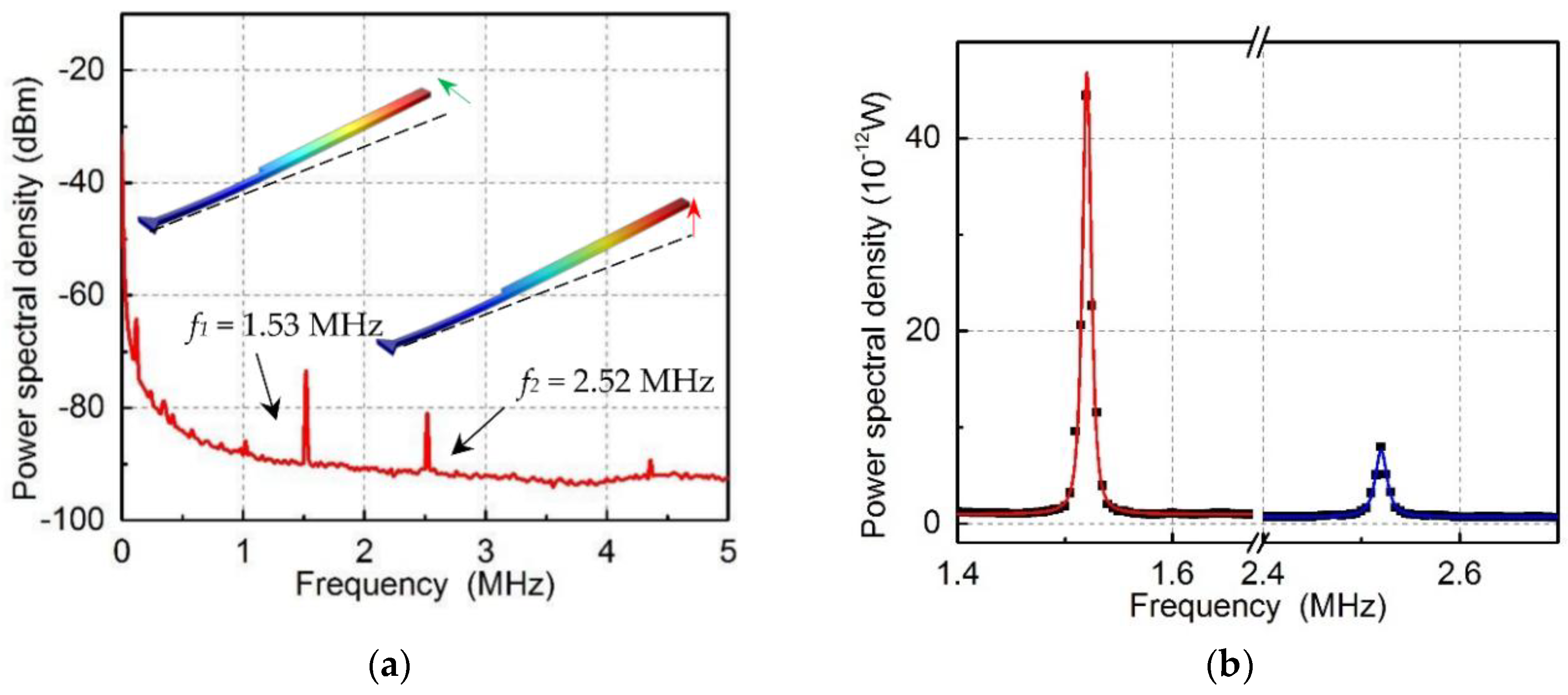
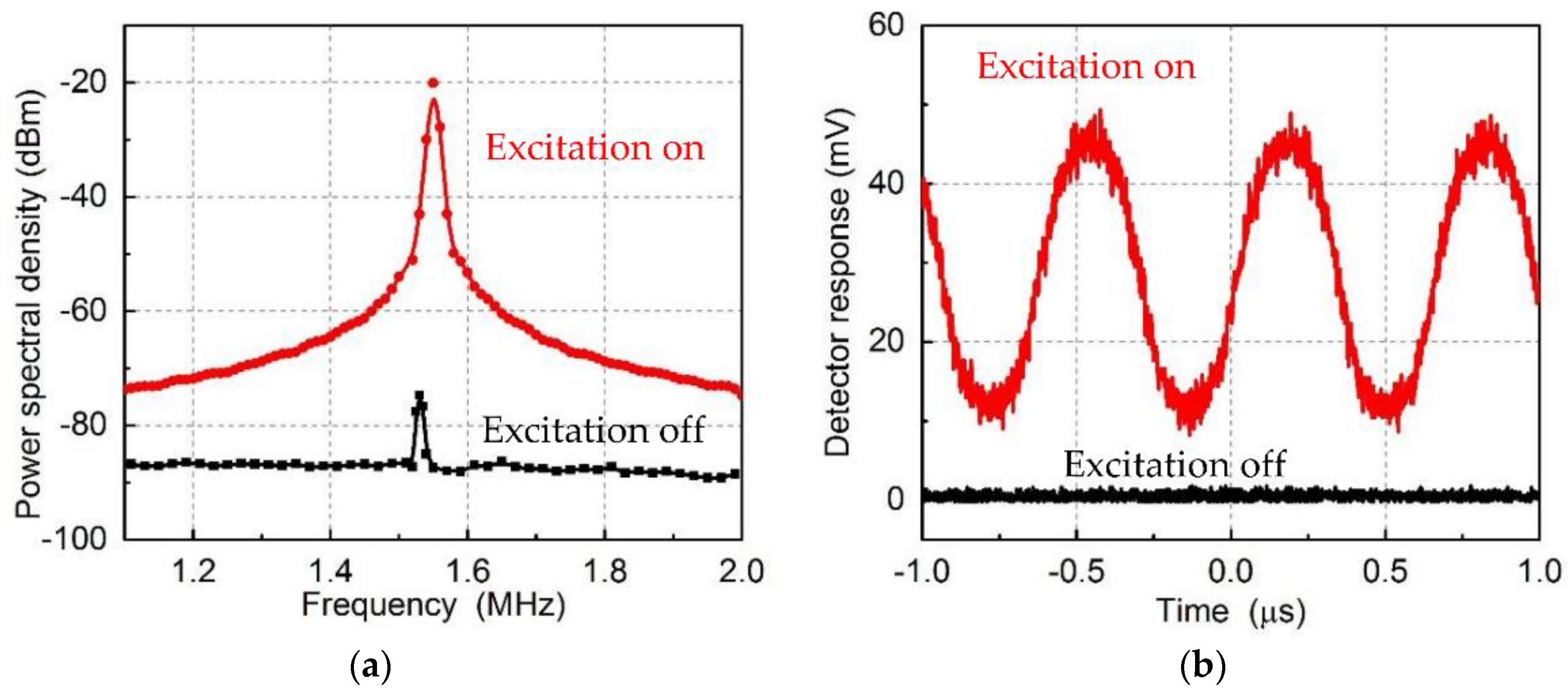
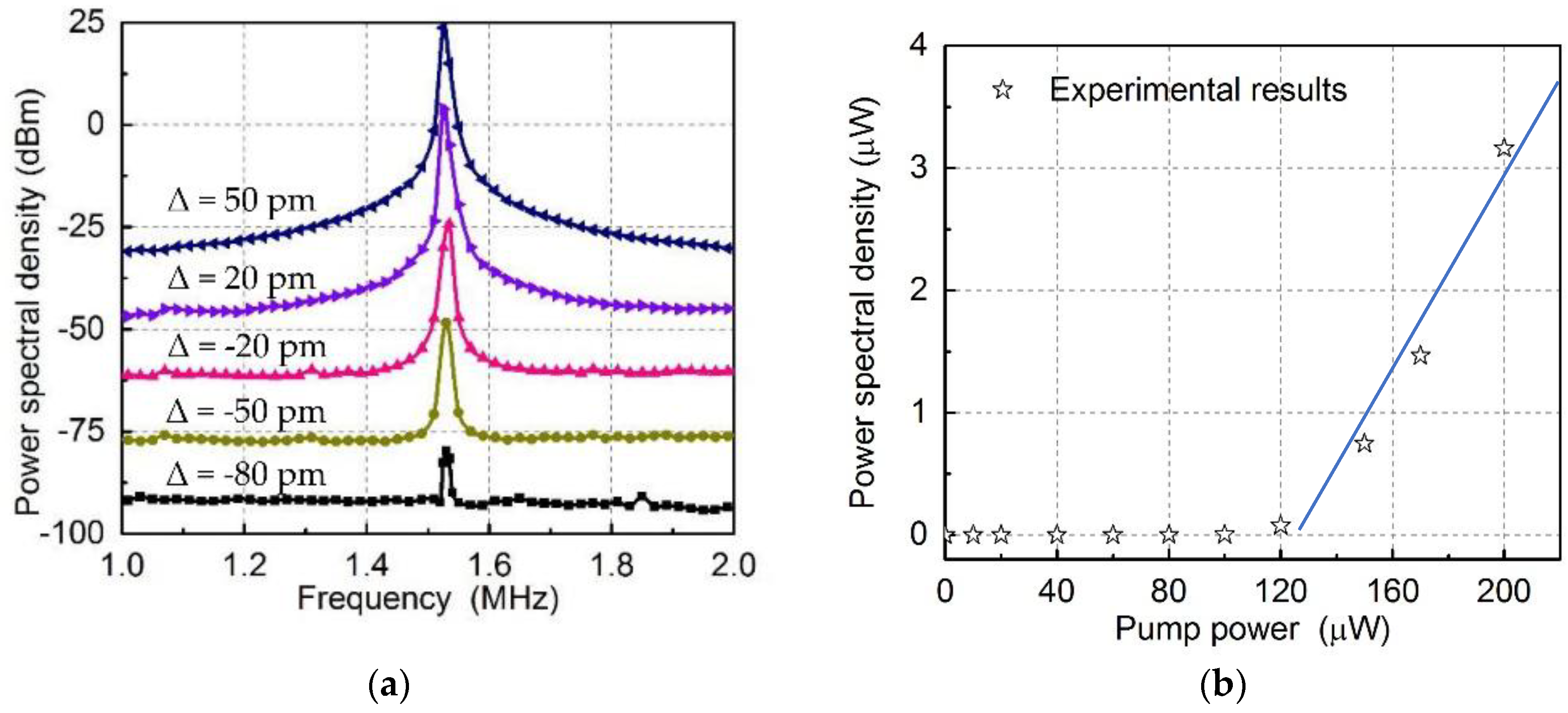
© 2018 by the authors. Licensee MDPI, Basel, Switzerland. This article is an open access article distributed under the terms and conditions of the Creative Commons Attribution (CC BY) license (http://creativecommons.org/licenses/by/4.0/).
Share and Cite
Huang, J.; Karim, M.F.; Wu, J.; Chen, T.; Liu, A. Parametric Excitation of Optomechanical Resonators by Periodical Modulation. Micromachines 2018, 9, 193. https://doi.org/10.3390/mi9040193
Huang J, Karim MF, Wu J, Chen T, Liu A. Parametric Excitation of Optomechanical Resonators by Periodical Modulation. Micromachines. 2018; 9(4):193. https://doi.org/10.3390/mi9040193
Chicago/Turabian StyleHuang, Jianguo, Muhammad Faeyz Karim, Jiuhui Wu, Tianning Chen, and Aiqun Liu. 2018. "Parametric Excitation of Optomechanical Resonators by Periodical Modulation" Micromachines 9, no. 4: 193. https://doi.org/10.3390/mi9040193




